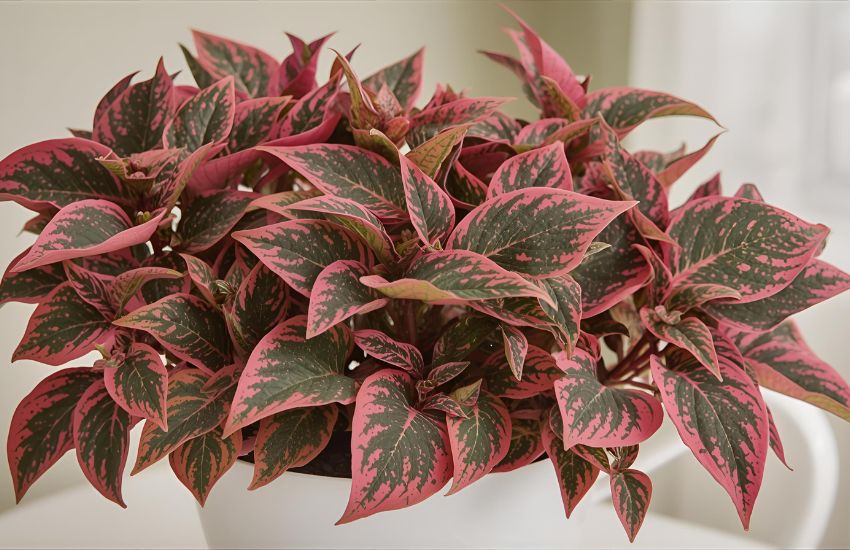The vibrant colours and striking patterns of crotons make them one of the most eye-catching choices when you want to add life to your indoor space. Among them, the Codiaeum variegatum, often known as the petra croton, stands out with its bold foliage and distinct leaf markings. This tropical shrub thrives as a houseplant when you understand its unique care requirements, from proper soil and drainage to the right balance of lighting, temperature, and humidity.
Croton Petra (Codiaeum Variegatum) is a striking houseplant known for its vibrant green, yellow, orange, and red foliage. To thrive indoors, it needs bright, indirect sunlight, warm temperatures, and consistent moisture without waterlogging. Maintain humidity and avoid cold drafts. With proper care, Croton Petra adds bold, colorful charm, making your indoor space lively and elegant.
In this guide, you will learn practical tips on how to grow and care for your petra croton indoors. From understanding its ideal tropical environment to choosing the best soil, adjusting humidity, and preventing common issues, this care guide will equip you with everything you need to enjoy thriving crotons year-round.
Understanding the Croton Petra: A Bold and Beautiful Variegated Croton Plant

A Striking Addition to Your Indoor Space
The variegated croton, also known as Croton Petra, belongs to the Euphorbiaceae family and is admired for its bold colored leaves and dramatic croton colors. This tropical plant is often chosen as one of the most striking house plants because of its unique hue and attractive coloration. When grown indoors, it brings a touch of the garden into your living space, standing out as a vibrant ornamental option.
Growth and Care Requirements
To thrive, your croton requires bright light but should be kept in indirect sunlight when grown indoors. Placing it near a window where it receives filtered sun will help maintain healthy colored leaves. Always water your croton properly—make sure to water thoroughly and allow the soil to dry slightly between waterings. During spring and summer, you will notice more growth, while in early summer, you may even spot a small flower.
Humidity and Environment
Crotons enjoy a humid atmosphere, and you can increase moisture by using a humidifier, a tray, or a pebble tray filled with water under the pot. This replicates its natural tropical plant environment. A mature croton indoors will retain its vibrant coloration if kept in the right balance of humidity and warmth.
Safety and Precautions
While this cultivar is admired for its beauty, you should know it is toxic to both humans and your pet. The milky sap can cause skin irritation, while ingestion may lead to nausea or vomiting. Always handle it with care, especially when you need to prune or propagate a croton plant through a stem cutting.
Outdoor and Garden Appeal
Although often grown indoors, crotons can also be planted outdoors in a garden if you live in a warm climate. They do best in full sun and develop richer croton colors in such conditions. With proper care, a mature plant becomes an excellent accent shrub in the landscape, adding long-lasting beauty.
Pest Control and Maintenance
Like many indoor plants, crotons can sometimes attract a pest infestation. Regularly inspecting the leaves and maintaining a balanced environment will keep your plant healthy. When cared for attentively, this variegated croton rewards you with lush foliage and brilliant coloration.
Conclusion
Caring for your Croton Petra is all about balance—providing indirect light while protecting it from harsh bright sunlight, ensuring adequate light with the help of a grow light if needed, and keeping the soil evenly moist without letting the plant become overly thirsty. Native to Malaysia, this striking evergreen shrub rewards you with brightly colored foliage in diverse leaf shapes, especially as autumn approaches.
Maintaining the right temperature range, proper watering, and good airflow will help prevent fungal issues, while regular inspection can protect against mealybug and spider mites. If leaves begin to wilt, it’s a clear signal that adjustments are needed. When fertilizing, always dilute the solution to avoid stress.
With consistent care, your Croton Petra will flourish and become a long-lasting centerpiece in your indoor garden. Now is the perfect time to embrace its tropical beauty—start applying these tips today and enjoy the year-round vibrancy of your Croton Petra!
Frequently Asked Questions (Croton Petra Care Guide: Codiaeum Variegatum House Plants for Vibrant Indoors)
How do you care for codiaeum Variegatum Petra indoors?
Codiaeum variegatum ‘Petra’ thrives indoors with bright, indirect sunlight and warm temperatures between 18–24°C. Keep the soil consistently moist but never soggy, allowing the top inch to dry before watering again. Maintain high humidity by misting or using a humidifier. Fertilize monthly during spring and summer. Avoid cold drafts and sudden light changes.
Does Petra croton like humidity?
Yes, Petra croton (Codiaeum variegatum Petra) thrives in high humidity. It prefers a warm, moist environment with humidity levels around 50–70%. Dry air can cause leaf edges to brown or drop. To maintain humidity indoors, mist the leaves regularly, place a humidifier nearby, or use a pebble tray with water under the pot.
How to make croton more colorful?
To make a croton more colorful, provide it with bright, indirect sunlight, as strong light enhances its vibrant leaf patterns. Keep the soil consistently moist but not waterlogged, and maintain high humidity levels. Fertilize monthly during the growing season with a balanced fertilizer. Avoid sudden temperature changes or drafts, as stress can dull its colors.
How often should you water a croton Petra?
Water a Croton Petra when the top 1–2 inches of soil feel dry, usually once a week, but adjust based on temperature and humidity. Keep the soil consistently moist, not soggy, to prevent root rot. In warmer months, it may need more frequent watering, while in cooler seasons, reduce watering slightly.
